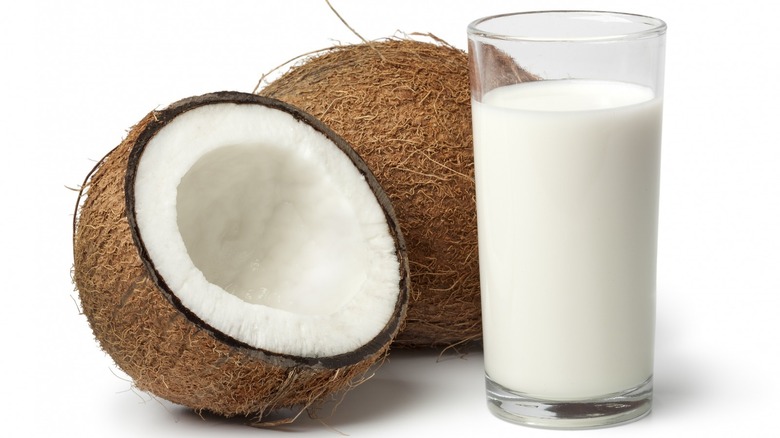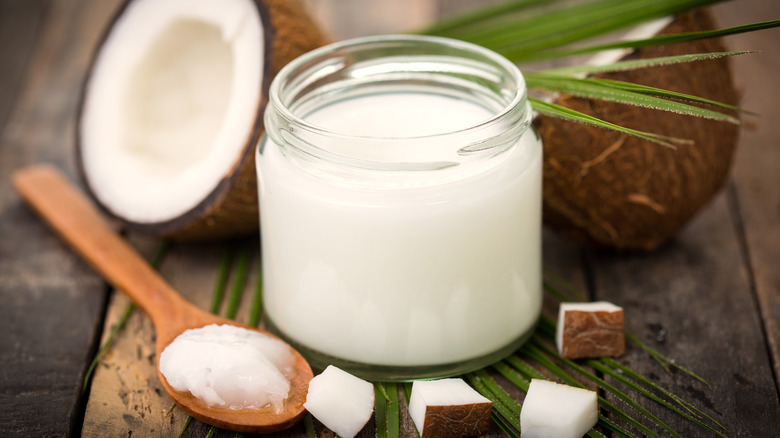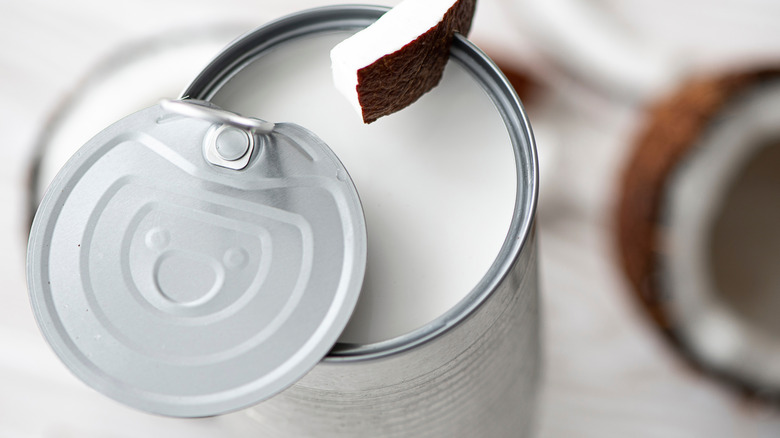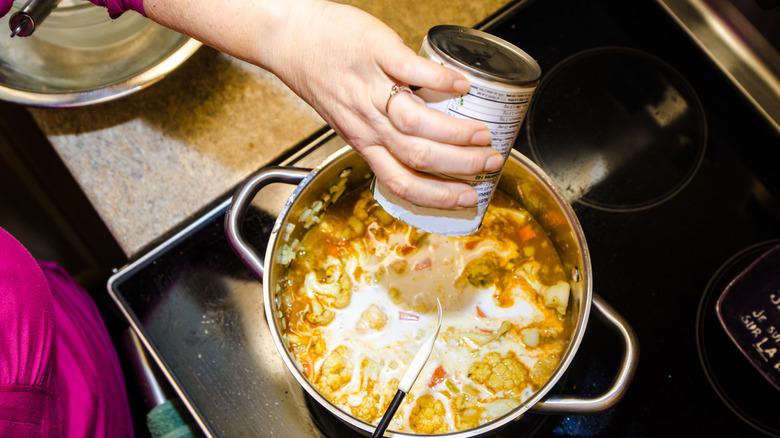Coconut Milk Is A Total Game-Changer For Omelet Texture
We may receive a commission on purchases made from links.
One day, you decide to set out and create the perfect omelet. Maybe you're trying to impress a new friend or maybe you're just hungry. Whatever the case, you've got your eggs at room temperature (which helps the omelet form quicker), a pad of unsalted butter melting in a sauté pan, a pinch of salt and pepper, a splash of ... coconut milk?
If you've traditionally added a bit of milk or cream to your morning omelet, you might find that you will have better results replacing it with an equal amount of coconut milk. Cow's milk actually doesn't mix that well with eggs, resulting in a watery omelet that sets up poorly and lacks appeal. Cracking open a can of coconut milk instead can improve your omelets considerably.
Coconut milk will not only add a slight nutty flavor to any omelet, but as Ixta Belfrage notes in her book "Mezcla" (via Epicurious), it adds "a creaminess that isn't overwhelmingly fatty like cream or butter."
Coconut milk vs. cream vs. water
When it comes to making the perfect omelet, not all coconut products are equal. Coconut cream and coconut milk are very different products, as are coconut milk and coconut water.
Of the three, coconut water, which is the liquid you will encounter in the center when cracking open a coconut (via Healthline), is the lightest. To get coconut milk, you need to take the meat within the coconut, soak it in hot water, and then squeeze, or milk, the liquid from the soaked coconut (via The Spruce Eats). Coconut cream starts with coconut milk that is chilled (via A Couple Cooks). This separates the layers of the coconut milk, after which you can easily skim off the top cream layer.
Of these three coconut liquids, coconut milk is the most nuanced, featuring both lighter layers and the oily cream layer, which adds a lot of texture to foods, including omelets. Coconut milk is such a texture game changer that you can even use it in something like scrambled eggs.
Coconut milk: also healthy and shelf stable
Coconut milk will not only improve the consistency of omelets and other foods such as curries, but it also brings with it a variety of health benefits. The most obvious? It's a great regular milk substitute for those who have a dairy allergy. Additionally, per Healthline, canned coconut milk contains up to 7.5 milligrams of iron per cup, and the lauric acid in it can provide a great boost to your immune system.
Coconut milk is shelf stable, meaning that you can keep an unopened can handy in your cupboard until you are ready to use it. Be sure to shake the can well before opening it to get the full range of flavor and texture of the milk into your omelet. And once opened, you should plan to use the refrigerated can within a week, as it tends to break down quickly once opened. A better option: freeze it!
Adding coconut milk to other recipes
If you've got coconut milk sitting around and don't know what to do with it, the possibilities are truly endless. As mentioned previously, coconut milk contains layers of texture, making it ideal for many recipes.
For instance, coconut milk can bring a creamier texture to dishes like mashed potatoes or creamed spinach. You can also substitute coconut milk for cream in alfredo sauce or soups to emphasize the silky texture while simultaneously adding nuanced flavor.
In general, coconut milk can replace standard dairy milk in any recipe without needing to edit measurements. If a recipe calls for a cup of milk, you can use a cup of coconut milk without worrying that the recipe's ratios will be thrown off. That being said, when using coconut milk as an alternative, remember that you will need to either balance or mask the coconut flavor if you don't want it to stand out.
How to balance out coconut milk's flavors
Fortunately, coconut milk's nutty and acidic flavors can be countered in many ways, so you can easily choose the method that best suits your recipe. For example, if you need to balance out the acidity in coconut milk, you can add a very small amount of baking soda. This particular method is especially helpful if you're making a dish that benefits from a bubbly, light texture.
If acidity isn't an issue, you may wonder how to balance out the sweetness in coconut milk. Ingredients like lemon juice or zest, vinegar, fresh herbs, or heat-packed spices can counterbalance sweetness, but again, you'll want to choose the ingredient that best complements your recipe.
Of course, on the other end of the spectrum, you can embrace the flavors of coconut and instead include additional complementary ingredients. Because coconut milk is sweet and rich, it pairs well with ingredients like fruit, chocolate, and even nuts. There are truly so many creative ways to use coconut milk when you aren't afraid to experiment.




